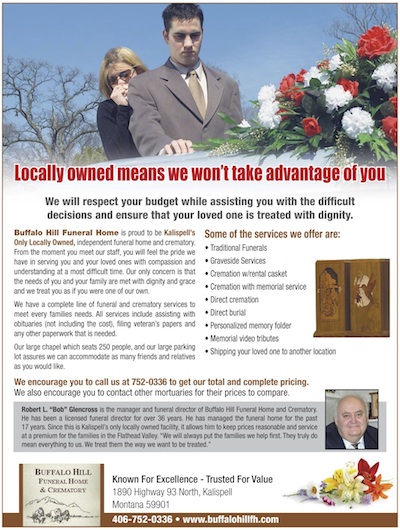No doubt, you all have at least one funeral home in your market you'd like to sell larger and more frequently.
This post shows you how, using our approach, the 17,500 circ. Daily Inter Lake ad sales team sold a funeral home a significantly larger ad with a long-term contract that's providing the advertiser with a great response.
It's just another case proving what we've been teaching our clients in our on-site seminars all along--that the key to driving serious newspaper ad revenue in this economy is to work smarter.
Specifically, your ad reps need to be able perform analysis and apply proven advertising techniques to information they've gathered, then create highly effective ad strategies that your (or our) designers can flesh out. And, of course, close the sale using our Socratic-style sales techniques. Without doing this, we and many of our clients believe you're slowly killing your newspaper (in fact, here's a test to see if this is happening to you).
While they may not know it, funeral homes desperately need to be running larger and more frequent ads. That's because there are relatively few people in the market for funeral services at any given point in time, so they can't risk missing any prospect. There's also plenty of competition, which adds to their challenge. And, it's nearly impossible to make a compelling case as to why to choose their funeral home over another within a small ad.
The good news is that with the right ad strategy, which we'll be discussing here, one or two sales will often make even the most expensive ads profitable.
While on-site teaching the Daily Inter Lake's ad reps, managers, and designers our Response Oriented Selling approach earlier this year, we conducted a seminar for the business community and afterward the owner of a local funeral home approached us.
He told us that unless you were in the business, people in this community would never know that he was actually the last locally-owned funeral home in his market. All the others had sold out to national chains, but since each had kept the local name and staff after the sale, nobody was ever the wiser that a corporate office was now in charge.
The problem, he explained, was that a good funeral home needs to be free to treat their community as their family. Many of their customers contact them at a highly vulnerable time and the good funeral homes won't take advantage of that. When owned by a larger corporation, he said, a local funeral home will naturally be pressured to put profits ahead of the customer, steering them into the more expensive products and services.
Of course, in a way, none of this matters when building the ad strategy. All that really matters is what the person about to choose a funeral home cares about. The funeral director told us that, above all else, their target customer wants to choose a place that simply won't take advantage of them.
The ad fell together easily after we learned that. We added a graphic at the top to grab the attention of anyone with a heightened awareness of funeral homes and before the reader left the ad (after all, they may already know of a place to go), we kept them with the ad by telling them what they cared about most: "Locally owned means we won't take advantage of you".
Then it was just a matter of explaining this in the ad. This is both the most critical and difficult part of creating the ad. We have to overcome the reader's natural skepticism with some compelling copy, which we were able to get from the prospective advertiser.
It's a shame we've all been taught "keep it simple" and "only use bulleted points" in an ad. That's a concept mistakenly taken from branding and image advertising. With most local newspaper advertising, however, we (and the customer) are looking for a strong response the very first time the reader sees the ad and before they leave the market. That, after all, may be the only time a reader is susceptible enough to the service to even see the ad.
Don't forget, your readers are highly literate and have no trouble reading paragraph after paragraph in your newspaper. Don't sell them short.


